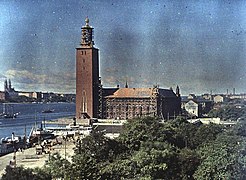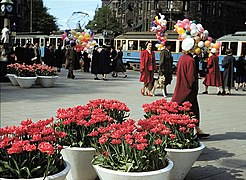Gustaf W. Cronquist
Gustaf Wernersson Cronquist (born September 8, 1878 in Stockholm , † 1967 ibid) was a Swedish amateur photographer who became known for his numerous color photographs of Stockholm.
biography
Cronquist was the son of Professor Werner Cronquist and his wife Mathilda (née Hoffstedt). After graduating as a chemical engineer at the Royal Technical University in Stockholm in 1900, he first worked as a chemist in the cement and brick industry, among others at the Klagshamn cement factory, or at Rhenania AG in Bendorf. In 1927 he became department head of the advertising company Gumælius annonsbyrå , where he stayed until his retirement.
Cronquist's great passion was photography , especially color photography, helped by his background as a chemist. He made his first color photographs on car chrome plates as early as 1908. In 1927 he published a small text entitled “Color in the City”, here he drew attention to the importance of color in the cityscape. Studies of facades and new buildings often appear in his motifs, but above all of everyday situations, mainly in Stockholm but also in the rest of Sweden. From his apartment he had a good view of the old town, Gamla stan , Slussen and Stockholm's harbor entrance. Many of his Stockholm pictures were taken here.
In the early 1930s he used Agfa's new Agfacolor film, which was still based on the grain grid method . When the Kodachrome film came out on the market in 1935 , he mainly used it for photographs and had it sent to him from the USA . The film initially had to be sent back for development and copying.
This transition in the photographic material can be clearly seen in Cronquist's pictures and these thus become a document on the technical development of color photography in the 20th century. The Autochrome photographs had clear grain and required long exposure times , which often resulted in motion blur . Kodak's new slide film was higher resolution and fast. But the new film didn't have the soft, saturated colors and the clear grain that gave his early pictures an artistic touch, which he himself regretted.
Cronquist was also committed to photography in general. In 1914 he asked in a photo magazine where were all the negatives that were made by amateur photographers all over the country. He said that these pictures, which are an important cultural and historical legacy, should be managed better, if necessary by a scientific institute.
In the course of time Gustaf Cronquist had one of the largest private color photo collections in Europe with around 50,000 pictures. Today around 5% of this is in the Stockholm City Museum . Cronquist was active with his camera until he was 85 years old and he left behind a unique color photo material from the beginning of 1900 to 1963.
He was married to Herta (nee Kallenberg, 1870-1935), a daughter of the businessman JL Kallenberg, and since 1962 to Marie (nee Erlandsson, * 1905) since 1908.
Examples
Stockholm's stadshus under construction in 1921
literature
- Cronquist, Gustaf W: son . In: Sten Lagerström, Elvan Sölvén (ed.): Vem är det. Svensk biografisk handbok 1967 . 28th year PA Norstedt & Söners Förlag, 1966, ISSN 0347-3341 , p. 173 (Swedish, runeberg.org ).
- Robert Garellick: Stockholmsfärg: fotografisk antologi 1910–1960 . Fälth & Hässler, Stockholm 1998, ISBN 91-630-6946-6 .
- Gösta Flemming: Centennium: Fotografi i Sverige . tape 1 . Svenska Fotografers Förbund, Stockholm 2008, OCLC 472548956 .
Web links
Individual evidence
- ^ Cronquist, Gustaf W: son . In: Sten Lagerström, Elvan Sölvén (ed.): Vem är det. Svensk biografisk handbok 1967 . 28th year PA Norstedt & Söners Förlag, 1966, ISSN 0347-3341 , p. 173 (Swedish, runeberg.org ).
| personal data | |
|---|---|
| SURNAME | Cronquist, Gustaf W. |
| ALTERNATIVE NAMES | Cronquist, Gustaf Wernersson |
| BRIEF DESCRIPTION | Swedish photographer |
| DATE OF BIRTH | September 8, 1878 |
| PLACE OF BIRTH | Stockholm |
| DATE OF DEATH | 1967 |
| Place of death | Stockholm |





